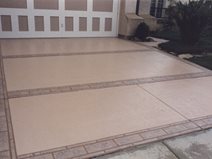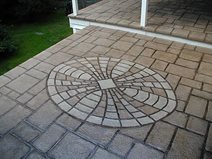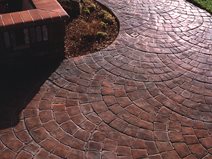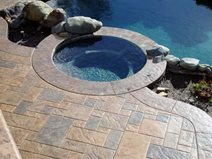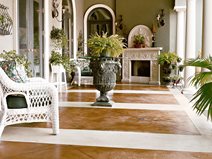- Staining Concrete
- Stamped Concrete
- Concrete Overlays
- Concrete Resurfacing
- Concrete Polishing
- Concrete Dyes
- Colored Concrete
- Indoor Concrete
- Concrete Floors
- Concrete Countertops
- Garage Floor Coatings
- Furniture, Sinks, Fire Bowls
- Basement Floors
- Outdoor Concrete
- Concrete Patios
- Concrete Driveways
- Concrete Pool Decks
- Outdoor Kitchens & Counters
- Outdoor Fireplace
- Concrete Walkways
- Concrete Pavers
- Concrete Walls
- Repair & Maintenance
- Foundation Repair
- Concrete Crack Repair
- Concrete Sealers
- Building with Concrete
- Concrete Homes
- Concrete Basements
- Decorative Concrete
Outdoor Concrete Restoration & Resurfacing
Learn how you can restore concrete driveways, patios and more through resurfacingRestore concrete by resurfacing it with an overlay to bring new life to your home or yard. Whether you want to improve the look of your patio, or cover up cracks in your driveway, resurfacing is a great option for outdoor concrete. Choose the surface you desire to transform below to learn more, get design ideas, and locate a resurfacing contractor in your area.
OUTDOOR CONCRETE RESTORATION
To learn more about restoration options for your concrete select from the options below. Once you're ready, contact a concrete restoration contractor near you.
Resurfacing Concrete Driveways
Improving the look of your driveway is easy with decorative concrete resurfacing. A thin layer of cement based material, or overlay, is applied directly to the existing concrete. Overlays have a wide variety of decorative options, ranging from coloring, stamping, and texturing.
Concrete patios with minor damage, but in otherwise good condition, can be transformed with resurfacing. Instead of starting over with a new patio, you can upgrade its appearance and strength with a cement-based overlay.
If the damage is superficial, as is often the case, it’s possible to restore and upgrade the appearance of your concrete walkway rather than go through the expense and hassle of replacing it. Resurfacing with a cement-based overlay or microtopping is a cost-effective option for adding a decorative touch to an existing concrete walkway while covering up minor flaws and discoloration.
Tired of your boring pool deck? Concrete pool deck resurfacing can spice up your old pool deck without the hassle of tearing out the old concrete and pouring new.
Concrete stairs or steps can also be restored, as seen in this project.
WHAT IS CONCRETE RESURFACING?
Resurfacing concrete is a great way to restore concrete with minor damage to the surface. Resurfacing also refreshes the look, through stamping, staining, or other decorative techniques.
Here are a few concrete problems that can be fixed with resurfacing:
- Cracks that are small and don’t compromise the structural integrity of the concrete.
- Spalling, or pitting, where the top surface of the concrete flakes away.
- Uneven concrete with minor variations that need to be leveled.
Other problems that can’t be fixed with resurfacing:
- Sinking, when severe, cannot be fixed with a resurfacing agent. More advanced techniques, such as slab-jacking or even complete removal for a new pour may be necessary.
- Heaving is when the concrete is lifted by shifts in the ground beneath the surface, usually by freezing water in the soil below or tree roots.
CONCRETE RESTORATION PRODUCTS
The most common products for restoring outdoor concrete are:
- Fillers and patches that help repair cracks and other damage prior to resurfacing.
- Stampable overlays that allow you to add imprinted texture to existing concrete.
- Texture coatings that offer a slip-resistant finish that is sprayed on and “knocked” down.
- Micro-toppings that provide a very thin, new layer for your concrete.
Other options include epoxy and self-leveling products, but these are more common for indoor restoration work. To find out which option is best for your project, contact suppliers of exterior resurfacing products or concrete repair products.
 Stampable Overlay Mix
Premixed blend for easy installation. From Brickform
Stampable Overlay Mix
Premixed blend for easy installation. From Brickform
 MT Resurfacer
Polymer modified micro-topping. Creates an abrasion resistant surface.
MT Resurfacer
Polymer modified micro-topping. Creates an abrasion resistant surface.
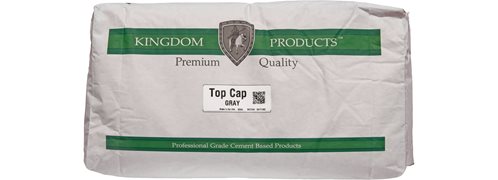 Top Cap Resurfacer
Spray down, knock down or cool deck finishes
Top Cap Resurfacer
Spray down, knock down or cool deck finishes
FREQUENTLY ASKED QUESTIONS
How durable and long-lasting is a concrete overlay? Will it wear well under heavy traffic?
When an overlay is applied properly and well-protected by a sealer or coating, it should last a lifetime, even under heavy foot or vehicle traffic. The key is to reapply the sealer if it begins to show some wear. Otherwise, wear patterns may begin to show, especially in colored surfaces. For more information, see Concrete Overlay Maintenance.
I love the look of stamped concrete. Can an overlay also be stamped and colored?
Absolutely! With stampable overlays, which are typically applied at a thickness of up to 3/4 inch, you can use the same stamping mats and texturing skins used for traditional stamped concrete to produce patterns and textures that mimic stone, brick, slate, and other materials. Texturing skins produce a seamless texture with no grout lines while mats produce a deeper pattern with well-defined lines. You can also add color using the same dry-shake color hardeners and antiquing releases used for typical stamped concrete.
Can a decorative overlay be applied to all existing concrete surfaces?
Not always. It depends on the condition of the existing concrete. The underlying base for an overlay must be sound. If your concrete is heaving, has severe cracks, or resting on unstable soil, an overlay will not fix your problems. If your concrete is simply discolored or has minor stains and cracks, then an overlay is an ideal way to cover up these surface imperfections and give your concrete a complete face lift.
Find more information about concrete overlays including all the basics to transform new or existing concrete. Here's a sample of topics you'll find:
- Types of overlays
- Special considerations
- Maintaining and protecting resurfaced concrete
- Much more...
